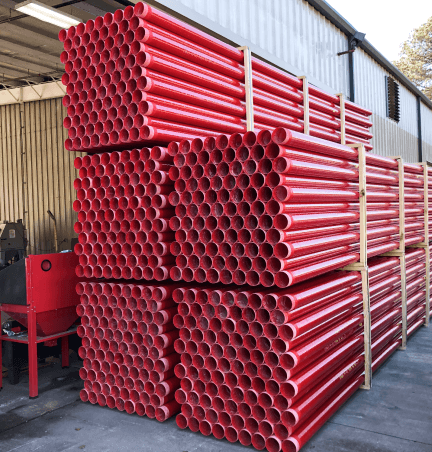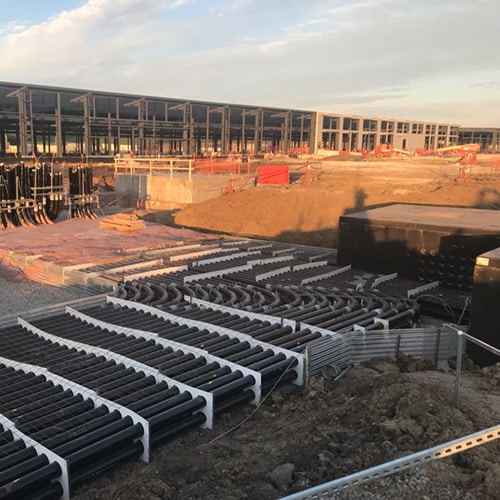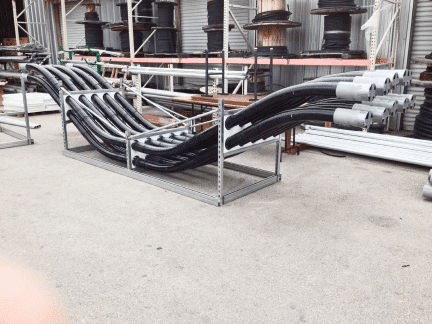There are several distinct joining techniques when working with electrical conduit, depending on the type of conduit used. Below you can learn more about the recommended techniques for joining fiberglass (RTRC) conduit.
Champion Duct®
Approved for use below ground, concrete encased and underbridge Champion Duct® boasts ease of installation, fire and corrosion resistance, excellent impact resistance and more. Joining techniques for working with Champion Duct include:
Interference Joint
The interference joint connection can be used for below-ground concrete encasement applications.
Some features of the interference joint connection are:
- Consists of bell and spigot
- For easy installation, the spigot end features buttress-type male threads; belled end features female mating threads
- Tapered threads make for quick, easy connection when properly seated
- High pull-out strength of 1,000 lbs. without adhesive
- Concrete-tight joint – not watertight
- The interference joint connection is provided with the following conduits:
– IPS conduits 2″ through 8″ diameters
– ID conduits 2″ through 6″ diameters - The interference joint connection will provide a concrete tight connection without the use of epoxy adhesive
- The interference joint connection can be used for above-ground applications when conduit sections are connected with epoxy adhesive (tight lock joint).
Gasket Joint (Triple Seal)
The gasket joint connection can be used with direct burial or concrete embedment underground applications.
Some features of the gasket joint connection are:
- Consists of bell and spigot
- The belled end has a triple seal gasket with interference joint
- Gasket seats into permanent groove wound into the conduit
- Concrete-tight and watertight joint
- High pull-out strength of 2,000 lbs.
- Pull-out strength of 500 lbs. without threads
- The gasket joint connection is provided with the following conduits:
– IPS conduits 3/4″ through 8″ diameters
– ID conduits 2″ through 6″ diameters
Tight Lock Joint
The tight lock joint connection is a permanent interference joint connection that utilizes the Champion Mix® epoxy adhesive. This connection can be used for above or below ground applications.
Some features of the tight lock joint are:
- The adhesive is applied to the spigot end of the conduit and inserted into the belled conduit end. Once cured, the adhesive joint has a tensile strength that surpasses the conduit glass substrate.
- The tight lock joint connection provides a watertight connection that can be used in above and below ground applications.
- The tight lock joint connection is only available in IPS and ID conduits sizes 2″ and above on SW, MW and HW epoxy resin conduits.
- The tight lock joint connection is available exclusively from Champion Fiberglass.
Haz Duct XW Type
Straight Socket Joint
The straight socket joint connection can be used for above and below-ground applications. Straight socket connection is also available with Champion Duct SW, MW, and HW.
Some features of the straight socket joint connection are:
- Consists of bell and spigot
- Spigot easily slides into the belled end
- Intended for use with Champion Mix® epoxy adhesive
- High pull-out strength
- Concrete tight and watertight joint.
- The straight socket joining system is provided with the following conduits:
– IPS conduits 3/4″ through 1-1/2″ diameters*
– ID conduits 8″ through 12″ diameters**
– XW conduits – all diameters
Straight socket connection (with adhesive) can be used for various applications:
- Below ground, direct buried, watertight joint
- Below ground, concrete encased
- Under bridge and above-ground installations
*Straight socket joint connection is available for sizes 2″ through 8″ upon request, otherwise interference joint is provided when available.
** Straight socket joint connection is available for sizes 2″ through 6″ upon request, otherwise interference joint is provided when available.
For more information, contact Champion Fiberglass or Find a Rep.












